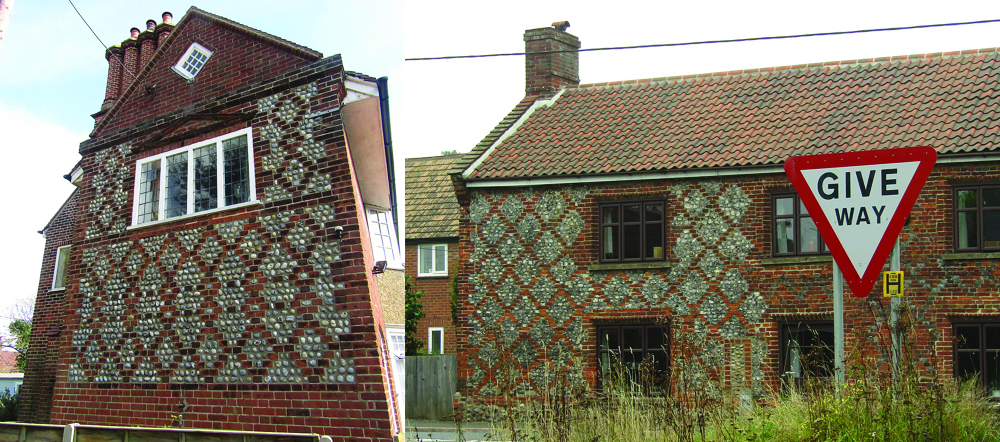Diapering in Construction
| Diaperwork or diapered flint by Kolforn under Creative Commons Attribution-Share Alike 4.0 International license |
Diapering in construction also called diaperwork refers the decorative treatment of a surface or facade with a repeating pattern of squares or chequers or rectangles. The terms stems from the latin 'dia' meaning across, describing the diagonal perpenicular lines creating diamond patterns.
It origins lie in Medieval times, often combining a flint stone wall with brick infill creating the repetitive pattern, an later with differing shades or materials of brick. It was a technique often used in Gothic and Tudor architecture often seen on churches, castles, and some houses to denote status and craftsmanship.
Diapering and the resulting geometric patterns can improve the visual interest of a facade, giving more depth and breaking the monotony of plain brick or flint surfaces surfaces and thus aesthetic value. It has also been used to create specific patterns or motifs that might represent the owner of the building such as guilds, religions, families or clans.
The technique to some extent can contribute to the structural integrity of a wall, with the interlocking patterns acting as structural ribs, distributing loads more evenly and potentially improving environmental resistance. Diapering might still be used today, often on brick facades likewise to add interest to plain brick surfaces. The employment of diapering today may be executed traditionally on site by a skilled brick layers or flinters (a flint worker) often on traditional buildings or off-site in the pre-production of modular building elements, brought to site and installed separately.
[edit] Related articles on Designing Buildings
- Airbrick.
- Aircrete blocks.
- Basic brickwork replacement.
- Blockwork.
- Bricklayer.
- Brick bats and closures.
- Brick burr.
- Brick sizes.
- Brick strip foundation.
- Brick veneer.
- Bungaroush.
- Cavity wall.
- Chalk aquifer.
- Clay.
- Clunch.
- Damp-proof course.
- Defects in brickwork.
- Dismantling of bricks for reuse.
- Efflorescence.
- Frog.
- Frost attack.
- Federation of Master Builders.
- How to lay bricks.
- Knapping.
- Limestone for building.
- Master mason.
- Masonry.
- Mortar.
- Pointing.
- Spalling.
- Specifying brick.
- Swift brick.
- The influence of geology on English brickmaking,
- Testing bricks.
- Treating brickwork with sealant or water repellent.
- Types of brick arches.
- Types of brick bonding.
- Types of bricks.
- Types of stone.
- Which way up should you lay a brick?
- Wall tie failure.
Featured articles and news
Latest Build UK Building Safety Regime explainer published
Key elements in one short, now updated document.
UKGBC launch the UK Climate Resilience Roadmap
First guidance of its kind on direct climate impacts for the built environment and how it can adapt.
CLC Health, Safety and Wellbeing Strategy 2025
Launched by the Minister for Industry to look at fatalities on site, improving mental health and other issues.
One of the most impressive Victorian architects. Book review.
Common Assessment Standard now with building safety
New CAS update now includes mandatory building safety questions.
RTPI leader to become new CIOB Chief Executive Officer
Dr Victoria Hills MRTPI, FICE to take over after Caroline Gumble’s departure.
Social and affordable housing, a long term plan for delivery
The “Delivering a Decade of Renewal for Social and Affordable Housing” strategy sets out future path.
A change to adoptive architecture
Effects of global weather warming on architectural detailing, material choice and human interaction.
The proposed publicly owned and backed subsidiary of Homes England, to facilitate new homes.
How big is the problem and what can we do to mitigate the effects?
Overheating guidance and tools for building designers
A number of cool guides to help with the heat.
The UK's Modern Industrial Strategy: A 10 year plan
Previous consultation criticism, current key elements and general support with some persisting reservations.
Building Safety Regulator reforms
New roles, new staff and a new fast track service pave the way for a single construction regulator.
Architectural Technologist CPDs and Communications
CIAT CPD… and how you can do it!
Cooling centres and cool spaces
Managing extreme heat in cities by directing the public to places for heat stress relief and water sources.
Winter gardens: A brief history and warm variations
Extending the season with glass in different forms and terms.
Restoring Great Yarmouth's Winter Gardens
Transforming one of the least sustainable constructions imaginable.























